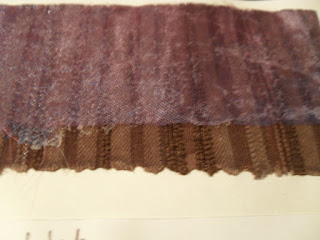Painted acrylic onto Tyvek, and then applied the heat. Paint makes Tyvek more resistant to heat and also darken with more heat applied:
Encased synthetic fabrics into a plastic wallet. Gives a rippled effect and melts through to material:
Used a soldering iron on synthetic fabrics and semi transparent plastic bags. The solder cuts but also joins, giving a spontaneous method, reveals paper as wont cut through:
Coccoon Stripping
Laid down strands of the natural fibres onto baking paper, sprayed with a light mist of water and covered with another sheet of baking powder. Ironed to compact fibres, can be sewn into.
Gummed silk fused with felt. Spread out the gummed silk, laid felt ontop and sprayed and ironed as before, rougher texture. can also be sewn into.
Making felt. Lay down fibres thinnly and then for the next layer , lay alternatively. Do 3-4 layers. Spray with water and use soap, cover in bubble wrap and massage so fibres fuse together Put in Hot and then cold water, iron and leave to dry.
Bonda Web - Place onto base material, cover and iron to heat glue, remove backing and let cool for a few seconds. Add top material and iron again.
Bonding powder- can control more, sprinkle onto material and iron under baking powder.
Bleach on velvet: spray on ink and iron in. Place template over and dab on bleach with a sponge, iron again and submerge in vinegar.











No comments:
Post a Comment